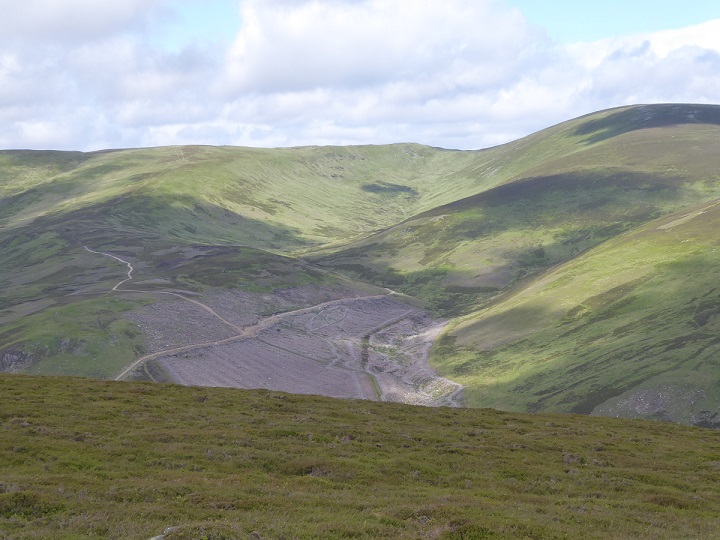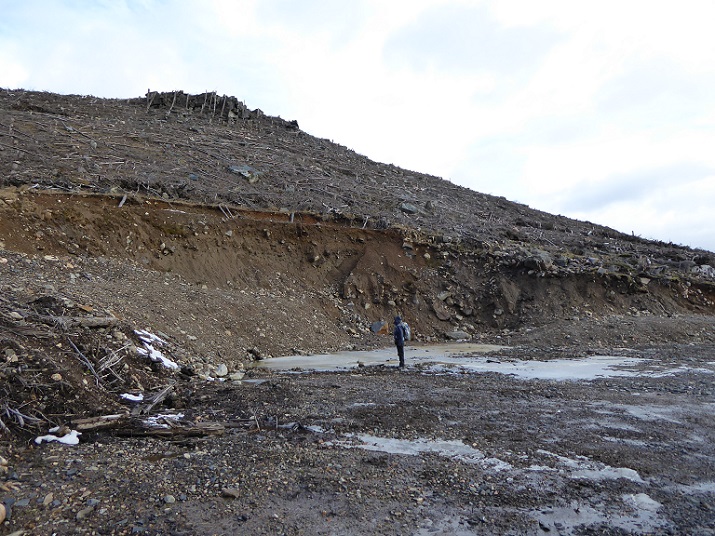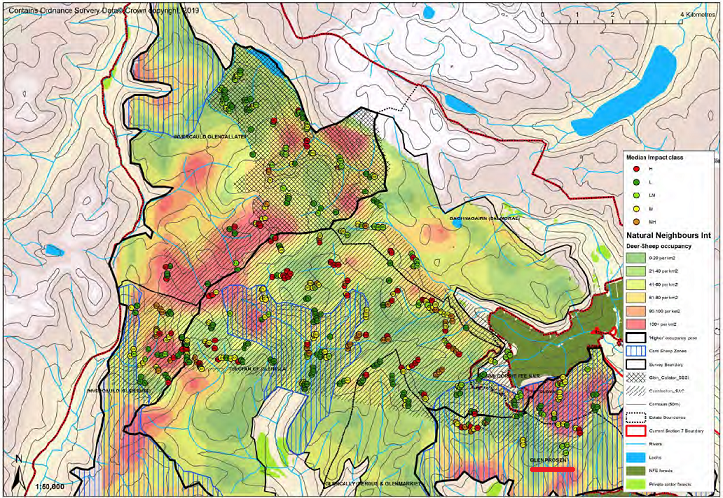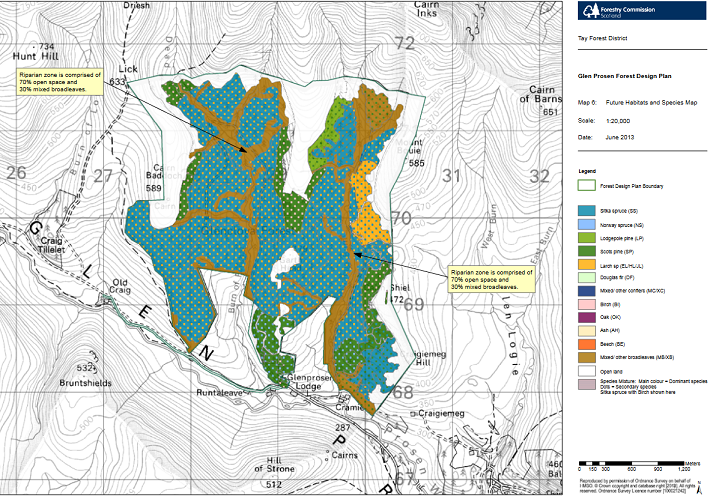
Last week it was reported (see here, for example) that Forest and Land Scotland (FLS) are to buy 16,500 acres from the Glen Prosen estate for £25m to plant trees. This raises a number of important questions about land ownership and land-use in the Cairngorms National Park. It also illustrates some of the weaknesses with the Scottish Government’s proposals for land reform set out in a consultation which is due to close on Sunday (see here) .
What has Forest and Land Scotland actually bought?
There is no information about the purchase on the FLS website and it not clear at present what they are buying. According to the Registers of Scotland, the Glen Prosen Estate covers 3453 hectares. This is equivalent to 8,532 acres or 8,000 acres short of the 16,500 acres reported in the press. Maybe Mr Batchelor also owned and is selling a neighbouring estate? But details for Balnaboth, for example, the 6000 acre estate next door where deer stalking appears to be managed by the Glen Prosen Estate, are still not available online on the Land Registry. It is therefore not possible to tell the extent of Mr Batchelor’s landholdings in the area.

The different colours mark different burdens within the area, “the cadastral unit”, owned by Mr Robin James Hill Batchelor. The green shows two acres controlled by Glen Prosen Sporting Ltd, a company (see here) whose sole director and owner is Simon William David Baird, and appears legally to be a completely separate entity to the estate.
If the acreage in the press reports are mistaken and FLS has only bought the Glen Prosen Estate, Mr Batchelor would appear to have made almost £21m from this property in the 11 years he has owned it:

I say “would appear” too because the £21m increase in the land value discounts the costs of any investments Mr Batchelor may have made in the estate, including the small hydro scheme. It is not yet public, however, whether the hydro and other proprietary assets such as the sporting rights are included in the sale and therefore what FLS has got for its £25m or the financial value to the public purse.
The state of the land

Most of the Glen Prosen Estate and FLS’ Glen Clova Forest landholding lies within the Cairngorms National Park – the boundary runs across the yellow on the map above. To date, the Cairngorms National Park Authority (CNPA) appears to have had very little impact on the way the Glen Prosen estate has been managed. I have written previously about the level of trapping on the estate (see here) and the visual impact of the hydro and hill tracks on the wild land area at the head of the glen (see here) but there is a lot more.
The Glen Prosen Estate was included in Scottish Natural Heritage’s Section 7 Agreement which was supposed to reduce the impact that red deer were having on the former Caenlochan National Nature Reserve (see here). According to the data I obtained about deer numbers on Caenlochan from an FOI in the summer Glen Prosen is remarkable, a deer free zone. What is more it helped reduce the average deer density across the area down to a mere 18 deer per square kilometre, just 8 more than the maximum recommended for Scotland!

Unfortunately, the figures are either pure tosh or someone made an extraordinary effort to drive deer out of the area before the census!
The final draft report from Strathcaulidh on Caenlochan, dated June 2020, which I also obtained through an FOI request provides lots of evidence to support my contention:

The most recent figure of 637 deer for 56.89 square kilometres, though better than ten years ago, still gives a deer density of 11 per square kilometre, above the maximum recommended in the report of the Deer Working Group. Moreover, evidence from Strathcaulidh’s Habitat Impact Assessment, which looked at the land that had been designated for nature conservation within the Caenlochan Section 7 Agreement area, found that the greatest number of grazing animals were on the western and eastern sides of the area, including land managed by the Invercauld and Glen Prosen estates.
Strathcaulidh conducted a number of different surveys (trampling, browsing, dung, animal counts) before reaching their conclusion:

These surveys took account of sheep and hares as well as deer and show high levels of sheep grazing takes place round the head of Glen Prosen. Any reduction of deer numbers on the Glen Prosen estate in recent years will have made no difference if they have simply been replaced by sheep.

If this picture was not bad enough, the parts of the Glen Prosen estate that have not overgrazed or used for industrial forestry have been burned.

In short, Glen Prosen is well and truly trashed and the case for public conservation ownership very strong.
But why should the public purse pay the landowner £25m for land that has been abused in this way? Surely, it should be the landowner that is paying the public to remedy all the damage they have caused not the other way round?
The message the Scottish Government appears to be giving through FLS is disastrous, that landowners can continue trashing the land for field sports for as long as they want but, if they ever do decide to stop and sell, the state will then step in to award them obscene profits.
What are Forest and Land Scotland’s Plans?
At present, the only clue as to FLS’ intentions are the press reports that it wants to plant trees and there has been no mention of any wider conservation purpose. This is important. If the sporting and/or grazing rights are not included in the sale, there will be nothing to prevent the sorry history of land mis-use continuing outside the planted areas, while the public will incur yet more expense erecting fences to protect trees.
FLS’ purchase of Glen Prosen appears to have been opportunistic, rather than being part of a coherent plan, since they were approached by the landowner. FLS may have responded positively because it fitted their acquisitions and disposals strategy (see here), a large part of which is about consolidating landholdings to increase “efficiency”. FLS also appear to have been sitting on large wads of cash, both from the disposal of other public forests and the £30m Low Carbon Investment Fund awarded to them by the Scottish Government. Add to that the pressure to plant trees, to meet Scottish Government targets, and Glen Prosen presented an opportunity to tick lots of corporate boxes for very little effort by managers.
The purchase allows FLS to add considerably to their existing landholding in the glen, Glen Clova Forest (see here), which is being managed as a productive forest and is mainly planted with Sitka spruce:

In the absence of statements to the contrary, there is a real risk that FLS intends to manage the whole of Glen Prosen in this way, adding to the environmental damage rather than restoring it.

Recently FLS asked the public to revise their expectations of how long it would take to “re-open” forests after Storm Arwen (see here). This was effectively an admission that the current model of intensive forest planting and clearfell has failed and is no longer economic under the market system.
The opportunity at Glen Prosen
Glen Prosen could therefore provide a perfect opportunity for the FLS to show it has changed course and to adopt a new model of woodland creation based on natural regeneration.
To enable this to happen the first thing that would need to happen is to stop muirburn and reduce grazing to very low levels (two deer per square kilometre and with any sheep grazing restricted to stock enclosures). FLS could then start planting trees without protective fencing outside the wild land area at the head of the glen. Such planting would need to be in small quantities and over several years to prevent the number of voles and hares exploding as a result of the new food source. Numbers of small browsing mammals would also be limited by the return of predators to the glen (the removal of all those traps).
Once the woodland became established, FLS could rely on natural regeneration to enable it to develop with a mixed age structure (what is called continuous cover forestry). The job of the forester would then be to weed out unwanted trees (which should include stopping sitka spreading into the wild land area and other areas designated for nature conservation) until the first productive trees reached maturity.
All this would be best managed by local foresters based in the glen and permanently on site, rather than through remote contractors. That would help show up the claims by sporting estate interests that the only viable jobs in the remoter parts of the Cairngorms involve game-keeping.
Such an approach would fully accord with the aims of the Cairngorms National Park. However, at present it is not even clear that FLS bothered to consult the CNPA before deciding to make the purchase.
Glen Prosen and the Scottish Government’s proposals for land reform
Many of the proposals included in the Scottish Government’s current consultation on land reform concern large hand holdings over 3000 hectares. Glen Prosen would meet that threshold but interestingly there appears nothing in the proposals that would affect how this sale has been managed or how the land might be managed in future.
The Scottish Government is proposing to restrict foreign ownership of land over 3000 hectares in size. That obviously doesn’t apply to the Forest and Land Scotland purchase at Glen Prosen. But if FLS has spent £25m on 16,000 acres or 6474 hectares that comes to £3861 a hectare. To buy 3000 hectares at that price would cost £11,584,800. The 3000 hectare proposal is therefore only likely to affect billionaires and been made redundant by recent land price inflation.
Where people do have the cash to buy estates over 3000 hectares in size, the proposal is they should be subject to a public interest test. That sounds good until you realise that the entire test is about the concentration of power that comes with large landholdings. If FLS’s purchase of estates like Glen Prosen is not regarded by the Scottish Government as being an unwarranted concentration of power, it is hard to see how the courts could judge against any other prospective purchaser!
What is needed of course, as I have previously advocated on parkswatch, is a public interest test into HOW the prospective landowner intends to manage the land. In my view in protected areas like National Parks this should include all but residential and industrial land-holdings and should include FLS just like everyone else. In other words before committing to buy Glen Prosen FLS should have had their plans vetted by the CNPA to ensure they were compatible with National Park objectives (eg the new National Park Partnerships Plan commits to natural regeneration and contains a presumption against deer fencing). The Scottish Government’s proposals include nothing to make this happen.
The Scottish Government is also proposing that all these large landholdings should have to produce land management plans and cites FLS’s forest plans as a model of good practice. The problem, however, is that the proposals contain no means of redress should these plans not meet broader policy objectives (like tackling climate change, the nature crisis, promoting the right to roam etc). The assumption is that by making landowners talk to local people about plans they will then do the right thing! Neither is there means of redress should the landowner, having produced a plan, then decide to do something contrary to it.
A good example for Scottish Ministers of why such means of redress are required is FLS’s recent decision to exclude the Aviemore and Glenmore Community Trust from managing the Glenmore campsite on the opposite side of the Cairngorms (see here). Why is it that the Scottish Government has allowed FLS to hand over £25m to a private landowner, siphoning money out of Scotland, but has been quite content that FLS exclude the AGCT for the sake of an unknown sum of money that would then have been invested in the local community?
As for transparency, there is nothing in the Scottish Government’s Land Reform proposals to improve the way information about landownership or use is recorded and provided on the Registers of Scotland or anywhere else. I have spent a day trying to assemble and make sense of the information provided in this post and that has only been possible because a successful FOI to Scottish Natural Heritage.
The timing of the news that FLS is intending to close a £25m deal on Glen Prosen could not have been better, it shows that the proposals in the Scottish Government’s consultation that is due to close tomorrow are not fit for purpose.
You’re in the wrong country Nick. You would be a lot better off in China. I’d have a word with the CPC. They’ve got it really bad over there. Hell on earth. Evils of communism. Everyone is just walking round in circles like a brainwashed zombie. Oh! Sorry. Wrong way round. I meant Scotland. Dialectics. https://youtu.be/GjVuQ7pYJ-I
Nick gives a well researched and considered opinion. You then go all out to insult and to deride without stating any facts or considered rebuttal of his arguments.
If you disagree then tell us all why Nick is wrong and like Nick use facts to back up your opinion.
This sort of mindless attack based on no presented evidence perhaps suggests rather than him go to China you should go to the US and join all the mindless conspiracy theorists
BTW I do not know the author and this is the first time I have read the Blog.
Not read your blog before,but wanted to thank you for all the effort in researching all this. I know the Glenporsen estate as a walker and it is one I usually avoid as a barren trap ridden spot, but am aware of what a great opportunity this purchase would give for gradual rewilding. Like you I am not hopeful based on the FLS management of other holdings in the area. What I d like to see in the Land Reform Bill would be much greater transparency , clear plans and direction from the large quangos which operate as government agencies. As I think you outline here it is pretty hard to hold other landowners to account when this is not happening
We all imagine public bodies to be open and transparent in their dealing, which they should be, but they continually avoid and evade the public when we request quite reasonable information. I think it possible that FLS will make their attempts at rewilding this estate. I think the reason for their name change is to signal a different era for FC of “rewilding” and at the same time wind farms over and above commercial forest management.
Rewilding in the UK, led by Rewilding UK set up by Lord Baron Zac Goldsmith MP and his brother Ben Goldsmith along with foreign national landowners, seems to involve a plethora of grant funded organisations planting native trees at distances that follow commercial forestry guidance and using trees that are not from the local seed bank, this destroys local biodiversity and increases risks of bio-security – it’s as if we have learnt nothing in the last few decades. Great opportunities are being missed in helping nature to heal itself by using local seed resources, recognising habitats transitional to climax woodland as having immense ecological value, realising that some human activities have and do create natural diversity, natural predation in a non-commmercial woodland is a vital part of its optimal ecology and that if we are to move forward sympathetically with nature we still need farmland which farmed extensively and organically produces very species rich and species diverse habitats for many rare species resident and visitor.
Although I can’t agree with Nick’s comments about private landowners trashing the Cairngorms National Park. Many and indeed probably most take their land ownership very seriously, and usually have a better record of promoting diversity than RSPB, FLS etc. I can however agree that FLS are unlikely to be good owners of Glen Prosen. The very pictures you show of what clear fell looks like from 1950’s planting is exactly what you are going to get from FLS. They will talk the talk and then suddenly oops 50% of the trees planted are Sitka Spruce in large blocks that will have a bit of rewilding around the edges, and a few native broadleaves just to keep the mainstream happy.
Nick you forget that open heather moorland is already a diverse environment supporting rare flaura and fauna, birds, mammals, insects, and is actually already a good form of carbon capture. It is a unique environment globally. I appreciate that its existence is supported by Red Deer and hill farming of highland breeds but these are all sources of fabulous low cholesterol meet, and support jobs and communities. Carpeting the landscape in sitka spruce destroys amenity value, and has questionable ecological credentials as a result of spoil mounding, erosion etc. I appreciate that you probably want to have the whole place rewilded and looking jolly for folk who think this is the perfect answer. But the reality is that that environment is highly unproductive does not support jobs or communities, requires ugly deer fences or culls of deer on a massive scale to support. We need to move away from the vindictive and politicised language around ‘grouse moors’ and field sports. These can be perfectly sustainable. We need to talk more about moorland and heather moorland management and agree where this fits with our overall objectives for a sustainable landscape which supports people, jobs and communities. Heather moorland is a precious environment and works best where humans manage it and drive income through sensibly managing wildlife numbers. The pro rewilding group should be working with these people for a shared vision of the uplands where Sitka Spruce and non native trees cannot be planted above 400 metres, but where a mosaic of open landscape mixed with native woodland can pertain.